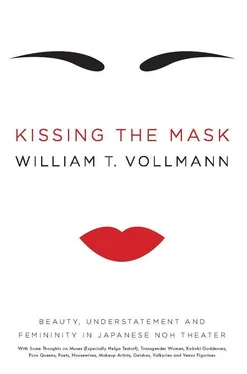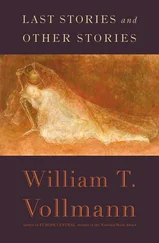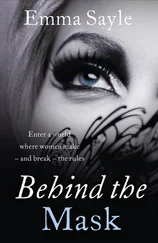1A Noh expert comments here: “Rokuro is the direct descendant of Minoru I, who was his great-grandfather (and the teacher of Fenollosa). Minoru I was of merchant stock, and married into the Umewaka family. So while the Umewaka tradition does go back a thousand years, long before Noh was thought of, it was by no means a direct patrilineal transmission. The situation since Meiji, in which the Umewakas have had a master actor every generation, is probably extremely unusual.”
2In Japanese usage the word “kimono” is in fact applied only to one of many kimono-like garments. Details may be found in the end note to this page. Rather than stiffen the text with more foreign words whose explication might distract, I have used “kimono” almost invariably throughout.
3For such dates, see Chronology.
4The Noh expert Jeff Clark amplifies: “ Shura is one of the six realms of… cyclic experience in Buddhism. It’s a psychological state in which one returns to battle again and again, something like Post Traumatic Stress Syndrome. The battle is horrible, but also is the most intense experience in the warrior’s life. It is what everything else in the warrior’s life is directed toward. I think this is what Rokuro meant by speaking of ‘under shura .’ In Buddhism, hell is returning to the same experience again and again.”
5Other sources say 1603 to 1867.
6I have been told that to the extent which one’s vision is limited by the mask, one’s hearing and concentration will proportionately increase.
7I am informed that this name means “cockscomb,” a double entendre which functions in both languages.
8How would I do it? When I engrave a line into a block of wood, I know that the tool will cut precisely as I expect it to; I have damped down my own self-assertion in order to tune myself to what the tool best does, watching the groove it forms, as if I were its spectator, although of course it’s I who’s making it. Still, I am more or less asserting myself; no one artistic school has shaped me. Mr. Umewaka, on the other hand, has undergone a lifelong stringent training in the Kanze aesthetic, tuning himself accordingly to so many, many tools: a chorus whose members, most of whom must be familiar to him, nevertheless comprise ever new combinations; the peculiar geometry of the Noh stage, the masks and kimonos, the drums. Were I to set out to play a modern female part after such an education, I’d wear high heels, to be sure, but perhaps instead of today’s machinegun clitterclacks of heels on concrete I might strive for something in harmony with the Noh drums, whose sounds are wooden, hollow, ancient, melodious; sometimes the drumbeats are almost like raindrops.
9I am taking Noh’s historiographers at their word, and predicating Noh upon the ritual of “Okina.” An expert comments here: “Until the Edo period, Noh was a popular art form patronized by the wealthy and powerful. Almost all the plays in the present repertoire were written during this period, and few of them can be described as quasi-religious rites, although they were often performed at temples or shrines… I believe that Noh has always required study; only an extraordinarily literate person could understand all the word play and classical allusions.”
10Indeed, there are not so many distinctions now, at least not in Tokyo. On the stage outside the window of the coffee shop, men pass by in dark suits, some with clenched fists at their sides, most with a briefcase, most with their heads erect; and instead of seeing them either as individuals or as part of a swarm, I attempt to consider them as exemplars of a type to be stylized on stage, a type doomed to pass into the void as do all other types; all of us are the last few cherry blossoms falling in the drizzly wind at Yasukuni Shrine, each of us caught in the electric stage-lights like a mote of fire; if any of these salarymen would kindly freeze, with the black-sleeved knife-edge of his arm pointing ahead and down, then I would have the luxury of really looking at him; instead, it’s incumbent on me as artist, journalist, idler, to generalize. (What would Zeami make of such a project? “As for the portrayal of high ranking officers and noblemen, or of natural things, such as flowers, birds, wind and moon, one must do it as realistically as possible. On the other hand, one must not copy the vulgar manners of common people.” Let’s hope that these office workers are sufficiently high ranking for me to model myself after.) And how do the women distinguish themselves from the men? Yamamura Yoko insisted that “there is not that much difference on the street that you can see, because mostly they wear Western clothes. If they wear kimonos, their steps are much shorter. Men wear hakama , so they can walk normally.” — What about gestures? I asked. “Now men and women are the same in that regard; but, again, in kimonos, women’s movements are more restricted.” Looking out my coffee shop window, I see very few kimonos. The women do frequently constrain themselves into mincingness by wearing high heels, but they seem to keep pace with the men nonetheless; their miniskirts and bluejeans allow them to put one foot before the other as heartily as any male; fewer than ever carry their purses in that traditionally vulnerable feminine way, the strap dangling from the crook of the left elbow, the wrist accordingly compelled upward into soft vague blindness; no, they let their shoulderbags hang free now, so that their arms can fall naturally like men’s; if they have purses, they tend to grip the handles in the left hand, just as would a man his briefcase.
11“What’s your opinion of Japanese ladies of ancient times?” I asked her. — “They are beautiful, but I wouldn’t want to be like them.”
12So it used to be. “In the past,” said Mr. Umewaka, “they only used masks for ghosts or dead characters. Black Jo for an old man, that’s it. In Yoroboshi, that blind man Shuntoku-maru, they didn’t use a mask. They just closed their eyes.”
13This play is discussed below, p. 357.
14In the olden days, the blackening was done with a lead-based pigment; for mask-teeth, sumi ink suffices.
15I own a book of photographs of the “last days of the Tokugawa Era,” and these brownish or bluish images, whose originals seem to be decaying usually from the edges inward, do portray people whose heads appear wider than those of today; to some extent this derives from photography’s standard trick of adding corpulence by forcing every visible feature of a head into one plane; flat maps of our round world suffer from kindred distortions. The flowing, cheek-hugging hairstyles of 1860 widen these faces somewhat further. Yet ladies’ hair is equally often pulled back from forehead and temples. High foreheads must have been as valued under the Shogunate as in the Heian period. Indeed, as I browse through this volume, I seem to find more and more the Japanese face of today , whose photographed expression, to be sure, is more somber and dull than now, on account of the need to hold still for those long exposures. This stillness, and the high foreheads, yes, perhaps these faces are a trifle Heian, but it’s mainly the faces of the children which widen toward the chin. From the side, one adolescent girl of 1860 resembles the Heian stereotype: little black eyes in a white face, a tiny rosebud of a mouth (well, mask-lips part more widely than that, but what can you do?), puffy, delicious cheeks; her hair is tucked up behind her, and her kimono sports an elegantly striped sash.
16Kiso lies in what used to be the domain of the Tokugawa Shogun. Many of the cypresses were thought to be inaccessible because they grew on steep hillsides, but during the “bubble economy” of the 1980s a considerable number got carried away by helicopter. Their use is now more or less restricted to maintaining the shrine at Ise and making Noh masks.
Читать дальше












